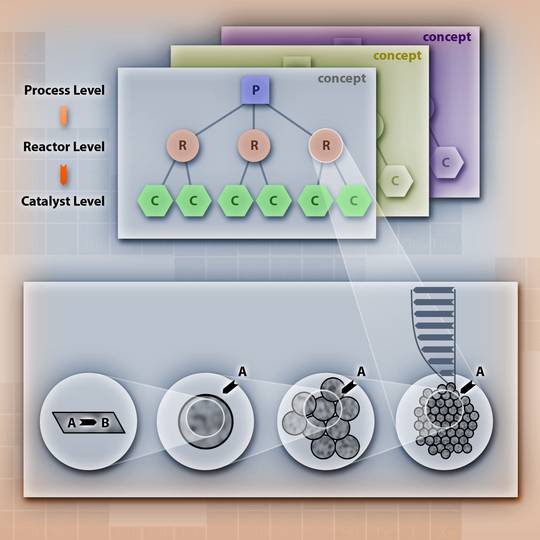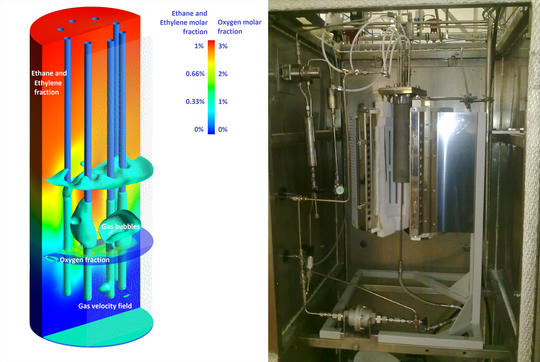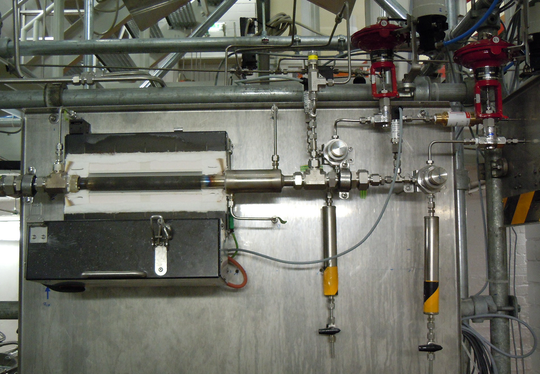C3 Process simulation with hierarchic models
State of the art
In chemical processes, many phenomena take place over different lengths and time scales. For each scale there are different numerical approaches and different programs. The different aspects of all of these scales must be integrated.
Research goals
A novel process simulator concept combining various methods at different levels of theory is being developed. On the one hand, the simulation starts with the results of ab initio quantum chemical methods for the prediction of molecular properties. The results will be used to describe the nanoscale behaviour up to the mesoscale processes. The transfer of these results to the mesoscale simulation with CFD and the macroscale simulation with the process simulator MOSAIC will be carried out. On the other hand, optimisation work on the macroscale has started considering uncertainties for the OCM processes Arco, UCC, Oxco, Suzuki and Turek-Schwittay, including gas purification processes, to determine the demands for catalyst development.
 |
A top-down approach and a classic bottom-up approach are being carried out in parallel. Demands for catalyst development will be defined in order to develop an economical process. Different reactor and downstreaming processes will be considered. Simulations on different levels will be integrated. Methods for experimental design and parameter identification for hierarchical models for OCM will be developed and applied to the OCM process.
This method will also be generalised for the biological process applications in Research Field C2.
Results/Achievements
Research area C3 links the fundamental research in Field A1 and the applied research in Field C4 on the basis of the mathematic description of the investigated process on all relevant length and time scales applying a multi-scale modelling approach. Here, all activities are dedicated to the OCM process. Molecular understanding of the reaction is provided from Research Field A1 by theoretical approaches and spectroscopic methods that give insight to the mechanism of the reaction. The combination with surface science contributions enables the development of a microkinetic model of the OCM reaction. For a variety of reasons the avail-able microkinetic models can not be used for the further development, because of wrong as-sumptions about the mechanisms, negligence of the gas phase and instability of the studied catalyst.
This leads to a strong need for a revision or even new development of a microkinetic model for the OCM. Because of the complexity of the reaction network this model can not be devel-oped simply from experimental studies, but requires strong theoretical support from Research Field A1. For the design of the reactor for the OCM process the microkinetic model is simpli-fied on the one hand and combined to the mass transport phenomena within real catalyst par-ticles on the other hand in order to provide a macrokinetic model. The model parameters of the macrokinetic model are fitted to experimental data obtained in systematic kinetic studies in Research Field A4, using a parallel reactor set system, and checked for consistency against the microkinetic model and thermodynamic data. This macrokinetic model would be later on used for the reactor simulation.
 |
In simulation studies optimal reactor types and operation conditions are identified and pro-posed for experimental realization within this Research Field, and experimentally investigated by Research Field C4. In this regard, fixed bed reactor, fluidized bed reactor, membrane reac-tor as well as network of different reactors were simulated. Those simulations took into ac-count all relevant hydrodynamic, mass and heat transport properties using CFD and 2D or 3D geometry, as well as complex reaction network [1 - 4]. Results were compared with experi-mental results obtained from Research Field A4 and C4. As a result novel hybrid reactor con-cepts were developed to cope with severe OCM reaction conditions as well as high demands in terms of heat management and high selectivity.
 |
The complete OCM process was designed as a mini-plant by a systematic process synthesis performed by process simulations of all options for this process. A global optimum with re-spect to a highly efficient utilization of feedstock and energy was identified and transferred to a detailed engineering within Research Field A4. From the process simulations the separa-tion of CO2 from the product stream was identified as very important process step, because of its high energy demand. Therefore a conventional concept was proposed as a benchmark and a membrane process as an innovative solution with substantially decreased energy consumption. The whole process design is accompanied with an evaluation of its economic efficiency and an estimation of the chances for industrial implementation in different environments.
The final product of the OCM reaction, ethylene, has recently been upgraded in terms of en-ergy savings used in its purification [4]. In the ethylene-ethane distillation tower the feed-splitting concept has been employed for an industrial production of 120,000 tons/y of ethylene with the OCM reaction. The goal of reducing the heat duty significantly required by the condenser has been achieved by almost 14% and simultaneously has been reduced (22%) the amount of heat duty required by the reboiler.
Using commercial simulation software, Aspen Economic Evaluation, an improvement has being done in the way of using the non-reacted methane from the OCM reaction to produce oxygenated products, such as formaldehyde and methanol. Recently paper accepted for publi-cation [5] has demonstrated the technical and economic feasibility of implementing the pro-duction of oxygenated products using the unreacted methane from the OCM reaction. The basis of the analysis is a world-scale conventional methanol plant that converts 22.6x105 m3 per day of methane (at 15 °C, and 1 atm) into 210 tons per day of methanol and generates 76 tons/day of formaldehyde. Capital and operating costs are for a remote location where natural gas is available at €12.60 per 1000 m3. Payout time for this process, with an OCM plant, is around 8 years. The economic evaluation was conducted for several different locations, in-cluding South America, Asia, Middle East and Russia.
Additional to the commercial process simulation software, a new web based modeling ap-proach is realized. So the modeling of non-standard OCM process units and corresponding processes is done by using programming languages. The improvement of the portability of such adapted models are generated from the document e.g. LATEX automatically.
The new modular modeling concept supports the group work of different persons and do-mains in UniCat and bases close to the documentation level. This concept includes working with symbolic mathematic expressions. Portability issues are addressed by automated code generation based on models described in XML/MathML. Reuse and cooperation between engineers shall be encouraged by providing the software as an internet-tool.
The above-mentioned modeling concepts including the internet aspect have been implemented in a modeling environment called MOSAIC. They are tested in different modeling projects and workshops. The user feedback is currently used to improve the usability and to detect and remove errors in the software.
The engineering part of this research area is a prototype for a project treating a process syn-thesis and design at a very early state of the development. This requires process simulations on an incomplete data basis and a substantial uncertainty in these data. The high degree of integration of the process steps represents another challenge for the design and optimization of the OCM process. These additional difficulties provide the chance for a substantial reduc-tion of the time for the process development.
The collaboration of theoretical chemists, chemical and process engineers in this project results in a beneficial exchange of information about all scales of the process with strong synergetic effects. In some case even the information about the accuracy of the data from the other field is an important contribution to the joined efforts.
The research on the OCM process is accompanied with a variety of activities for improving the engineering tools in this field, especially the tools for global process optimization and for the simulation of process dynamics. This research in the methodology is a strong worldwide development and performed in various collaborations. The members of UniCat (Wozny, Kraume, Schomäcker) collaborate with further German research groups in Magdeburg (Seidel-Morgenstern, Sundmacher, Kienle) and Dortmund (Behr, Schembecker, Engell) within a new collaborative research center (InPrompt) about the development of integrated catalytic processes in multi phase systems. In collaboration with Prof. Marquardt, Aachen, dynamic models of adsorption colums are developed. Collaborations with Prof. Biegler, Carnegie Mel-lon University, and Prof. Barton, MIT, are focused on new methods for process optimization (Wozny).
Most important publications
- H. R. Godini, H. Arellano-Garcia, M. Omidkhah, R. Karimzadeh, and G. Wozny; Model-Based Analysis of Reactor Feeding Policies for Methane Oxidative Coupling, Ind. Eng. Chem. Res. 2010, 49, 3544–3552; DOI: 10.1021/ie900182q
- S. Jaso, H.R.Godini, H.Arellano-Garcia, M.Omidkhah, G.Wozny; Analysis of attainable reactor performance for the oxidative methane coupling process, Chemical Engineering Science 2010, 65, 6341–6352 DOI:10.1016/j.ces.2010.08.019
- T. Eppinger, K. Seidler, M. Kraume; DEM-CFD simulations of fixed bed reactors with small tube to particle diameter ratios, Chemical Engineering Journal 2011, 166, 324–331 DOI:10.1016/j.cej.2010.10.053
- S. Jaso, H. Arellano-Garcia, G. Wozny; Oxidative coupling of methane in a fluidized bed reactor: Influence of feeding policy, hydrodynamics, and reactor geometry, Chemical Engineering Journal 2011, 171, 255-271; DOI: 10.1016/j.cej.2011.03.077
- Salerno, D. Arellano-Garcia, H. Wozny, G.; Techno-economic analysis for ethylene and oxygenates production using the oxidative coupling of methane reaction, AIDIC Confe-rence Series Vol. 11 2011.
- Salerno, D. Arellano-Garcia, H. Wozny; Ethylene separation by feed-splitting from light gases, Energy (2011), doi: 10.1016/j.energy.2011.03.064
- S. Stünkel, M. Brehmer, T. Brinkmann, J.-U. Repke, R. Schomäcker and G. Wozny; Carbon dioxide capture for the oxidative coupling of methane process – a case study in mini-plant scale, Distillation Absorption 2010
- S. Jaso, H.R. Godini, H. Arellano-Garcia, G. Wozny; Oxidative coupling of methane Reactor performance and operating conditions, (ESCAPE20-Italy), Special Issue in Computer Aided Chemical Engineering, pp. 781-786, 2010.
- S. Kuntsche, H. Arellano-Garcia and G. Wozny; Web-Based Object-Oriented Modelling Environment For The Simulation Of Chemcial Processes, Chemical Engineering Transactions 18 (2009), 779-784.
- S. Kuntsche, H. Arellano-Garcia and G. Wozny; A New Modeling Environment Based on Internet-Standards XML and MathML, Computer Aided Chemical Engineering 28 (2010), 673-678. doi:10.1016/S1570-7946(10)28113-0
- S. Kuntsche, F. Manenti, G. Buzzi-Ferraris and G. Wozny; Modeling in the documentation level using Mosaic and numerical libraries, Chemical Engineering Transactions 24 (2011), 343-348.
- S. Kuntsche, H. Arellano-Garcia and G. Wozny; MOSAIC, an environment for web-based modeling in the documentation level, Computer Aided Chemical Engineering 29 (2011) 1140-1144.
- S. Kuntsche, T. Barz, R. Kraus, H. Arellano-Garcia and G. Wozny; MOSAIC a web-based modeling environment for code generation, Computers & Chemical Engineering, Article in Press, doi: 10.1016/j.compchemeng.2011.03.022
Project team and expertise
| Dr. Raimund Horn (FHI, TU Berlin) | Micro-macro kinetic |
| Prof. Dr. Matthias Kraume (TU Berlin) | CFD simulation |
| Prof. Dr. Robert Schlögl (FHI) | In situ studies of model and real catalysts, synthesis and func-tional testing |
| Prof. Dr. Reinhard Schomäcker (TU Berlin) | Reaction engineering |
| Prof. Dr. Peter Strasser (TU Berlin) | High throughput testing, fuel cells, electrocatalysis |
| Prof. Dr. Günter Wozny (TU Berlin) | Process simulation, process optimisation |
Former team members | |
| Prof. Dr. Frank Behrendt (TU Berlin) | Macro kinetic |
| Prof. Dr. Martin Schoen (TU Berlin) | Monte Carlo simulation |
| Prof. Dr. Matthias Scheffler (FHI) | kMC, ab initio DFT |
| Prof. Dr. Joachim Sauer (HU Berlin) | Quantum mechanical studies of reaction mechanisms on surfaces and in clusters |

